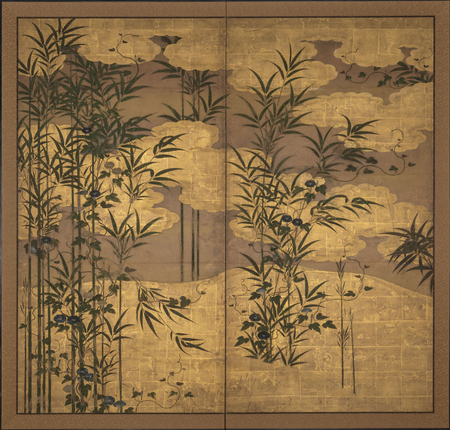Product Description
7765 A two-fold paper screen painted in ink and colour with morning glory and bamboo amongst golden clouds
Japan 17th century Edo period
Dimensions: H. 172cm x W. 180cm (67¾” x 71”)
Provenance:
From the collection of James Benson OBE (1925-2018). (James Benson worked as a submariner during World War II and later became the Vice Chairman of Oglivy & Mather International.)
Originally purchased from Milne Henderson Oriental Art, London.
Morning glory (asagao) has a long history in Japan since it was introduced in around the end of eighth century. Originally, up until the Heian period (794-1185), it was highly appreciated for its medical use of the seeds. Later it was cultivated for its beauty especially from the Kamakura period (1185-1333) onwards. During the Edo period (1603-1868), it became associated with the legendary meeting of the deities Orihime and Hikoboshi, two separated lovers who were allowed to meet once a year on the seventh day of the seventh month, making its flower auspicious. A variety of colours and sizes of flowers were bred from the late Edo period and potted morning glories were widely sold at markets in large cities.
For its refreshing beauty and auspiciousness, morning glories are popular in Japan, often depicted in literature, poetry and artworks. Although the flower blossoms in summer, it represented early autumn in traditional poems. As a subject of paintings, it was often included in the famous grouping of aki no nanakusa (seven grasses of autumn).
It is also notable that morning glory were particularly favoured by the Rimpa School artists who painted traditional subject matter in a bold, stylised manner to produce decorative paintings with gold or silver backgrounds. The most famous example would be a pair of six-fold screens ‘Morning Glories’ by Suzuki Kiitsu (1796-1858) in the collection of the Metropolitan Museum of Art (accession number: 54.69.1, .2). Other Rimpa-School artists such as Ogata Kōrin (1658-1716), Tawaraya Sōri (active ca. 1764-80), Nakamura Hōchū (d. 1819), Sakai Hōitsu (1761-1828), Tatebayashi Kagei (act. mid-Edo period) and Kamisaka Sekka (1866-1942) also painted its flowers and vines in various forms such as screens, hanging scrolls and fans.*
Bamboo represents strength, vitality, flexibility, dependability and survival through adversity due to its evergreen nature and delicate structure which bends in the wind, but never breaks. Its core is empty and this emptiness symbolises purification and an egoless state, highly regarded in Buddhism. In its own right, together with other plants or as one of the Three Friends of Winter along with the plum and the pine, bamboo is one of the most popular plants in Japanese culture.
*For the paintings depicting morning glories by the Rimpa School artists, see:
Kobayashi Tadashi ed., Rimpa Painting Volume II: Seasonal Flowering Plants and Birds, (Japan, 1990), p. 149-155, no. 250-261;
John Carpenter, Designing Nature: The Rinpa Aesthetic in Japanese Art, The Metropolitan Museum of Art exhibition catalogue, (New York, 2012), p. 190-195, no. 91-95.








